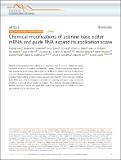Chemical modifications of adenine base editor mRNA and guide RNA expand its application scope
Author(s)
Jiang, Tingting; Henderson, Jordana M.; Coote, Kevin; Cheng, Yi; Valley, Hillary C.; Zhang, Xiao-Ou; Wang, Qin; Rhym, Luke H.; Cao, Yueying; Newby, Gregory A.; Bihler, Hermann; Mense, Martin; Weng, Zhiping; Anderson, Daniel G.; McCaffrey, Anton P.; Liu, David R.; Xue, Wen; ... Show more Show less
DownloadPublished version (1.178Mb)
Publisher with Creative Commons License
Publisher with Creative Commons License
Creative Commons Attribution
Terms of use
Metadata
Show full item recordAbstract
© 2020, The Author(s). CRISPR-Cas9-associated base editing is a promising tool to correct pathogenic single nucleotide mutations in research or therapeutic settings. Efficient base editing requires cellular exposure to levels of base editors that can be difficult to attain in hard-to-transfect cells or in vivo. Here we engineer a chemically modified mRNA-encoded adenine base editor that mediates robust editing at various cellular genomic sites together with moderately modified guide RNA, and show its therapeutic potential in correcting pathogenic single nucleotide mutations in cell and animal models of diseases. The optimized chemical modifications of adenine base editor mRNA and guide RNA expand the applicability of CRISPR-associated gene editing tools in vitro and in vivo.
Date issued
2020-04Department
Koch Institute for Integrative Cancer Research at MIT; Massachusetts Institute of Technology. Department of Chemical Engineering; Massachusetts Institute of Technology. Institute for Medical Engineering & Science; Harvard University--MIT Division of Health Sciences and TechnologyJournal
Nature Communications
Publisher
Springer Science and Business Media LLC
ISSN
2041-1723